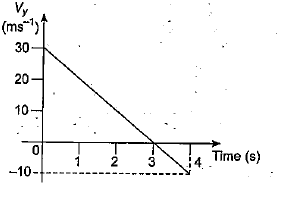
The velocity-time graph for the vertical component of the velocity of a body thrown upwards from the ground and landing on the roof of a building is given in the figure. The height of the building is:

(A) 50 m
(B) 40 m
(C) 20 m
(D) 30 m
(E) 10 m
Answer
218.1k+ views
Hint: We know that the velocity of an object is the rate of change of its position with respect to a frame of reference, and is a function of time. Velocity is equivalent to a specification of an object's speed and direction of motion. An object which moves in the negative direction has a negative velocity. If the object is slowing down then its acceleration vector is directed in the opposite direction as its motion, as we can see that in this case, a positive acceleration. Velocity is a vector quantity; it has magnitude which is speed and direction. Even though the speed is constant in this particular example, the direction changes all the time. The velocity of an object changes when the net force acting on it is not zero. Based on this concept we have to solve this question.
Complete step-by step answer:
We know that,
Height = area under v-t graph
So, now the height $=\dfrac{1}{2}\times 30\times 3-\dfrac{1}{2}\times 10\times 1$
On the further evaluation we get:
$=\dfrac{1}{2}\times 90-\dfrac{1}{2}\times 10$
$=45-5=40m$
Therefore, the height of the building is 40 m.
Hence, the correct answer is Option B.
Note: For solving such questions we should know that velocity time graph is representation of variation of velocity of any moving object with respect to time. This graph could be any type. For accelerated or retarded motion, the line in Vt graph would not be parallel to any axis. If the acceleration is positive, then the line is an upward sloping line which means the slope is positive. If the acceleration is negative, then the velocity-time graph is a downward sloping line which means the slope is negative.
We know that the two parts of a vector are known as components and describe the influence of that vector in a single direction. If a projectile is launched at an angle to the horizontal, then the initial velocity of the projectile has both a horizontal and a vertical component. A sloping line on a speed-time graph represents an acceleration. The sloping line shows that the speed of the object is changing. The object is either speeding up or slowing down. The steeper the slope of the line the greater the acceleration.
Complete step-by step answer:
We know that,
Height = area under v-t graph
So, now the height $=\dfrac{1}{2}\times 30\times 3-\dfrac{1}{2}\times 10\times 1$
On the further evaluation we get:
$=\dfrac{1}{2}\times 90-\dfrac{1}{2}\times 10$
$=45-5=40m$
Therefore, the height of the building is 40 m.
Hence, the correct answer is Option B.
Note: For solving such questions we should know that velocity time graph is representation of variation of velocity of any moving object with respect to time. This graph could be any type. For accelerated or retarded motion, the line in Vt graph would not be parallel to any axis. If the acceleration is positive, then the line is an upward sloping line which means the slope is positive. If the acceleration is negative, then the velocity-time graph is a downward sloping line which means the slope is negative.
We know that the two parts of a vector are known as components and describe the influence of that vector in a single direction. If a projectile is launched at an angle to the horizontal, then the initial velocity of the projectile has both a horizontal and a vertical component. A sloping line on a speed-time graph represents an acceleration. The sloping line shows that the speed of the object is changing. The object is either speeding up or slowing down. The steeper the slope of the line the greater the acceleration.
Recently Updated Pages
Apparent Frequency Explained: Formula, Uses & Examples

Calorimetry: Definition, Principles & Calculations

Centrifugal Force Explained: Definition, Formula & Examples

Charge in a Magnetic Field: Definition, Formula & Examples

Charging and Discharging of a Capacitor Explained Simply

Combination of Capacitors: Series and Parallel Explained

Trending doubts
JEE Main 2026: Application Form Open, Exam Dates, Syllabus, Eligibility & Question Papers

Derivation of Equation of Trajectory Explained for Students

Hybridisation in Chemistry – Concept, Types & Applications

Understanding the Angle of Deviation in a Prism

Understanding Collisions: Types and Examples for Students

How to Convert a Galvanometer into an Ammeter or Voltmeter

Other Pages
JEE Advanced Marks vs Ranks 2025: Understanding Category-wise Qualifying Marks and Previous Year Cut-offs

Units And Measurements Class 11 Physics Chapter 1 CBSE Notes - 2025-26

NCERT Solutions For Class 11 Physics Chapter 8 Mechanical Properties Of Solids

Motion in a Straight Line Class 11 Physics Chapter 2 CBSE Notes - 2025-26

NCERT Solutions for Class 11 Physics Chapter 7 Gravitation 2025-26

Understanding Atomic Structure for Beginners




